In this article, You will read Longitudinal Division of Himalayas i.e. Regional Divisions of Indian Himalayas for UPSC IAS.
The Himalayas, the abode to the highest peaks on the earth, are an incredible mountain system of Asia and a great wall between the Plateau of Tibet to the north and the alluvial plains of the Indian subcontinent to the south. It is divided longitudinally into 4 divisions from west to east.
Longitudinal Division of Himalayas
Indian Himalayas are divided longitudinally into 4 divisions from west to east.
- The Kashmir /Punjab/ Himachal Himalayas
- The Kumaun Himalayas
- The Central/ Nepal Himalayas
- The Assam/ Eastern Himalayas
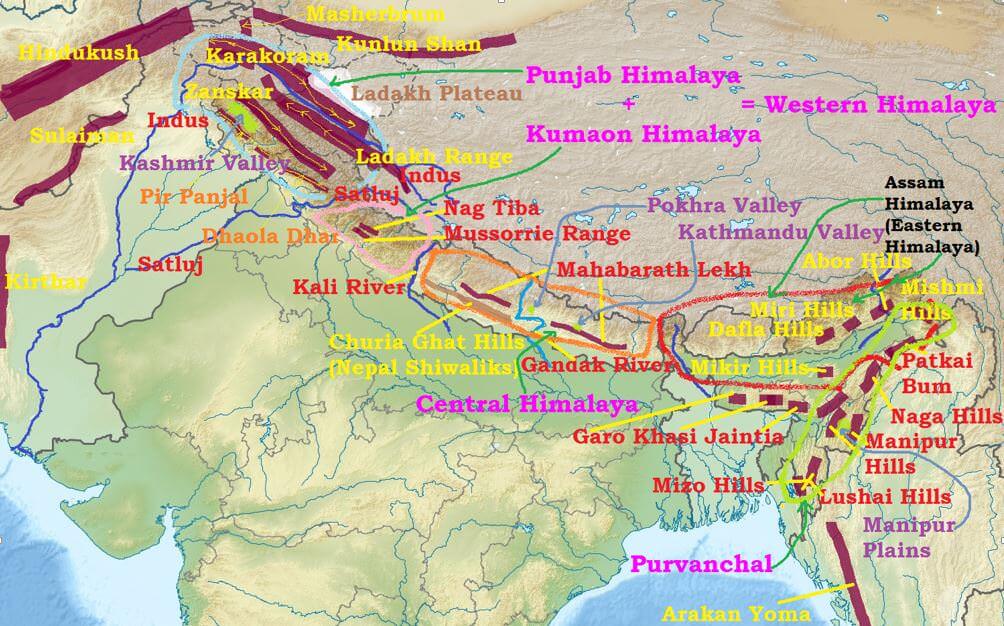
Kashmir /Punjab/ Himachal Himalayas
- Punjab Himalayas are located b/w Indus gorge and Satluj gorge
- They are 560kms long, width 320kms wide
- It has Zaskar range forming the northern boundary and the Shiwaliks, the Southern boundary
- The region with ridge and valley topography ( Kashmir Valley is the syncline basin) which have been formed by the Lacustrine deposits of River Jhelum.
- It has a number of ox-bow lakes like Wular lake, Dal lake, etc
- It is also called “Vail of Kashmir” and Lacustrine deposits are Karewas, which have special nutrients that help in growing Saffron, from Pulwama to Pampore.
- It receives 100cm rainfall and snow during winters
- It is surrounded by slopy mountains of Zaskar and Pir Panjal where alpine grasslands are called Bugyals or Marg, like Sonmarg, Gulmarg.
- It is also called “Heaven of the Earth”
- Other ranges are Ratanpir, which joins Pir Panjal.
- The only gateway to Kashmir is the Banihal pass which has the Jawahar tunnel (Second Largest in India)
- There are several passes in Greater Himalayas which connect Kashmir Valley to Ladakh and other regions like Burzil pass, Zozila pass.
Kumaun Himalayas
- Located b/w Satluj and Kali gorges
- Kumaun Himalayas extend for 320kms
- The major mountain ranges include Nagtiba, Dhaula Dhar, Mussourie, and parts of the Greater Himalayas.
- Major peaks include Nandadevi, Kamet, Badrinath, Kedarnath, etc.
- There are several glaciers and ice caps especially in Uttarkhand giving rise to a number of rivers – Gangotri, Yamunotri, Pindari, etc.
- It receives snowfall during winters and have coniferous forests above 3200m and Deodar forest (Deodar forest) b/w 1600-3200m.
- This region has two important basins Bhagirathi Plain and Doons. Kulu, Manali, and Kangra are tectonic valleys.
- Hill stations are famous because of their climate and colonial heritage
- This region has 200cm of rainfall and its more vegetated than the Kashmir Himalayas but prone to Seismicity and landslides because the rocks are fractured and fragile especially the lesser Himalayas is composed of loose rocks like shale, limestone, and conglomerates.
Central/ Nepal Himalayas
- Located between river Kali in the west and river Tista in the east.
- It is 800kms long
- Some of the world-famous peaks Mt. Everest(Sagarmatha), Kanchenjunga, Makalu, Annapurna, Gosainthan, and Dhaulagiri are located here.
- These mountains have orthoclinal plan and have the famous Katmandu valley.
- The Lesser Himalaya is known as Mahabharat Lekh in this region.
- The range is crossed by rivers like Ghaghara, Gandak, Kosi, etc.
- In between the Great and the Lesser Himalayas, there are Kathmandu and Pokhra lacustrine valleys (previously, they were lakes).
- The Shiwalik range comes very close to the lesser Himalaya towards the east and is almost non-existent beyond Narayani (Gandak).

Assam/ Eastern Himalayas
- It is 750kms long and is located b/w the Tista river in the west and the Brahmaputra river(Dihang gorges) in the east.
- Eastern Himalayas occupy mainly the areas of Arunachal Pradesh and Bhutan.
- Greater Himalayas are identifiable at lesser and Shiwaliks are inseparable in many parts.
- Longitudinal valleys are narrow and rainfall is greater than 200cms.
- The Assam Himalayas show a marked dominance of fluvial erosion due to heavy rainfall.
- However, ice caps and glaciers were not found because it is close to the tropics, densely forested but landslides
- Earthquakes are very common as rocks are fractured
- Inhabited by tribes
- The names of ranges are synonymous with tribes
- These mountains are intersected by several ferocious rivers
- This region is very dissected.
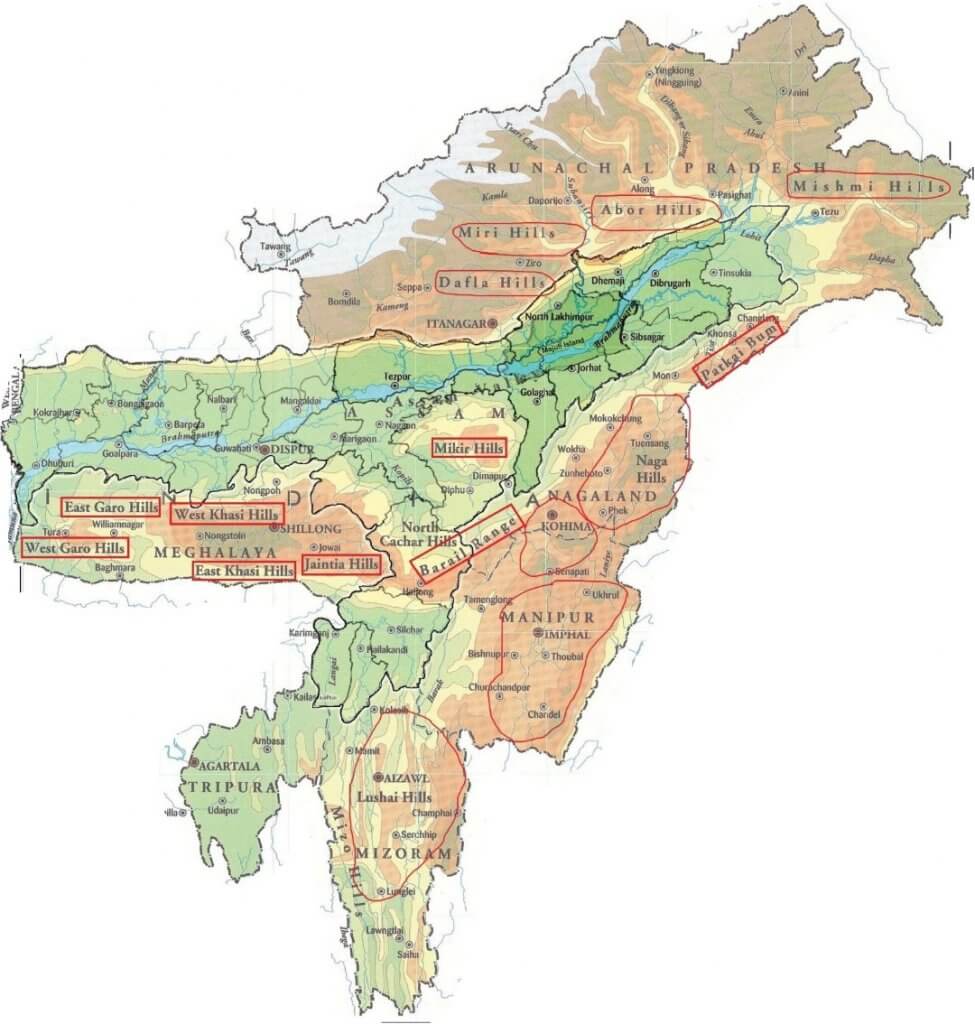
Purvanchal
- Geologically it is considered part of the Himalayas, but there are structural differences, thus, separated from the main Himalayan ranges.
- The Purvanchal Range lies south of the Brahmaputra valley.
- It has Naga hills where the highest peak Saramati is located
- Manipur hills – Loktak Lake where the only floating national park of the world is located
- Keibul-Lamjao national park
- Mizo hills – Earlier known as Lushai hills and the highest part is Blue Mountain.
- These mountains belong to Arakan Yoma orogenesis.
- They have loose and fragmented sedimentary rocks like shale, mudstone, sandstone, quartzite
- This section is the most fractured part of the Himalayas.
- It has the Naga fault line, thus prone to earthquakes and landslides
- Rainfall is 150-200 cms, densely forested but due to shifting cultivation ecology is at stake.
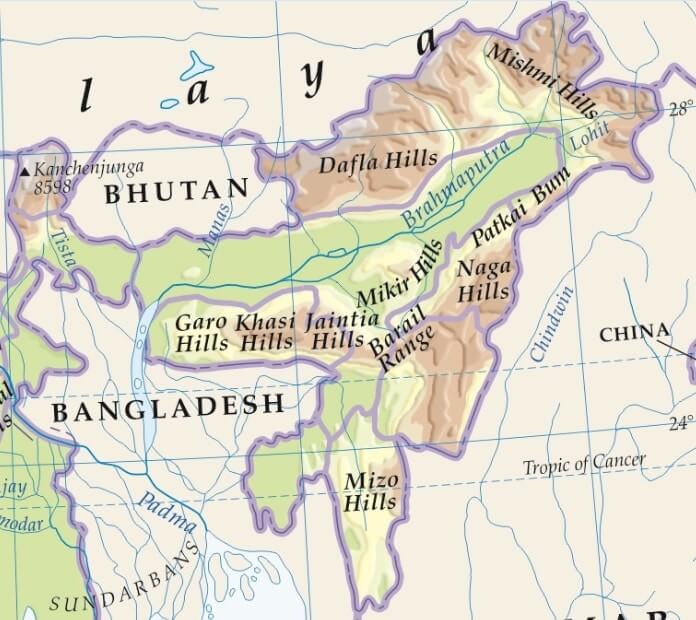
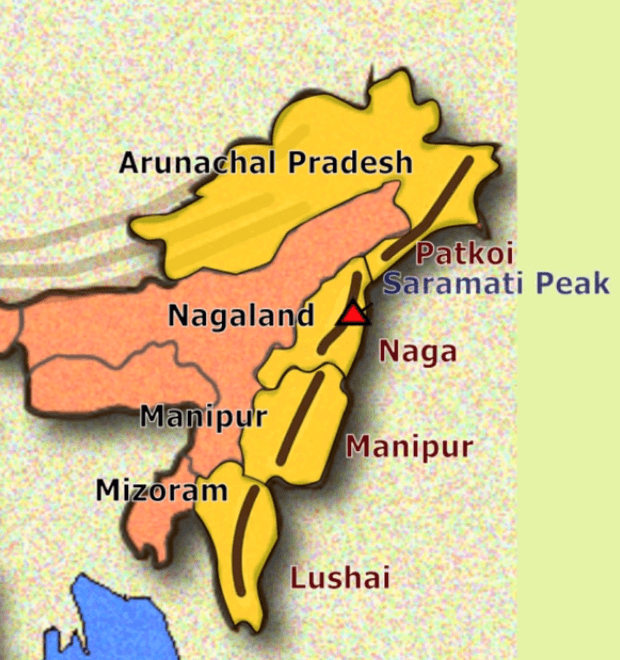
Trans-Himalayan Ranges
- The Trans-Himalayas Mountain Region or Tibet Himalayan Region is located to the north of the Great Himalayas which is consists of Karakoram, Ladakh, Zaskar, and Kailash mountain ranges.
- These mountains were lifted much before the Himalayas b/w Jurassic and Cretaceous, and geologically they are not part of the Himalayas.
- They emerged from Pamir Knot.
- Karakoram has the largest and highest peak Godwin Austin or K2 which is the highest peak of India.
- Siachen glacier is the highest battlefield and glacier Baltaro is the largest mountain glacier.
- Karakoram pass which connects the Aksai Chin which is an erosional plateau of average height 4000m.
- Ladakh range – The highest point is Rakaposhi and the extension in Tibet is called Kailash Range from where River Indus originated. Also, the origin of Brahmaputra is near the great glacier Marium La divides Indus and Tsangpo rivers. River Indus flows b/w Ladakh and Zascar
- Zaskar Range – Zaskar and the great Himalayas are very well clubbed together. The highest point is Nanga Parbat separated by Ladakh and Zaskarbasin.
- Ladakh Plateau – Cold desert and in the northwestern part, the Deosai mountains are the end of the Trans-Himalayan region.
- Trans Himalayan region generally receives rainfall during winters, mostly barren and cold desert.
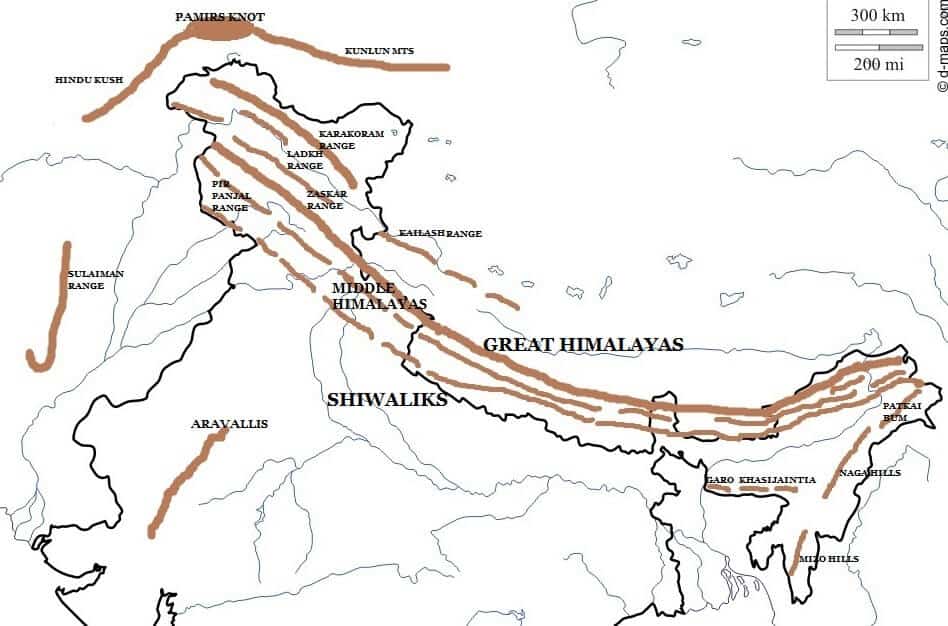
The highest peak in India – K2
The highest peak in India of Himalaya – Kangchenjunga
| Mountain Peak | Height (in meters) |
| K2 (Godwin-Austen) | 8611 |
| Kangchenjunga | 8586 |
| Nanda Devi | 7816 |
| Kamet | 7756 |
| Santoro Kangri | 7742 |
| Saser Kangri | 7672 |
| Mamostrong Kangri | 7516 |
| Rimo | 7385 |
| Hardeol | 7151 |
| Chaukamba | 7138 |
| Trisul | 7120 |

best material. Really happy that you are providing such good material for free
best notes ever. thanks alot
Thanks
Oh my God!!! We can’t thankyou enough for this…..This is beyond amazing…We will crack this exam and give you the credits for enriching us with such wisdom that too for free. Notes are covering everything and they are well updated.
your notes help me a lot thankyou
it covers all the points that important for the exam thankyou
good info
AWESOME
thank you